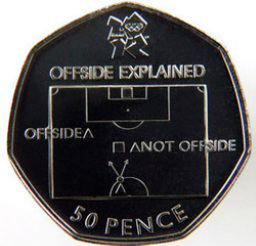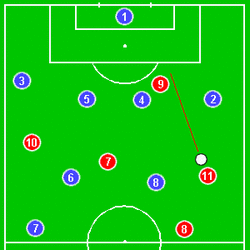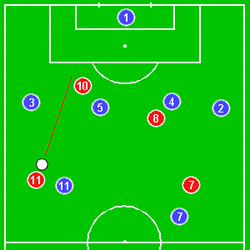- HOME
- MINDSET
- T-SHIRTS
- JUST4KEEPERS GOALKEEPER TRAINING
- UNDERSTANDING GOALKEEPING
- LAWS of SOCCER
- Law 1: The Playing Field (Pitch)
- Law 2: The Ball
- Law 3: The Number of Players
- Law 4: The Player's Equipment
- Law 5: The Referee
- Law 6: Assistant Referee
- Law 7: The Duration of the Match
- Law 8: The Start and Stop of Play
- Law 9: Ball in and out of Play
- Law 10: The Method of Scoring
- Law 11: The Offside
- Law 12: Fouls and Misconduct
- Law 13: Free Kicks
- Law 14: Penalty Kicks
- Law: The Throw In
- Law 16: The Goal Kick
- Law 17: The Corner Kick
- FIFA
- WOMEN'S SOCCER
- 2014 WORLD CUP
- 2010 WORLD CUP FINAL
- LIVE SCORES and LEAGUE STATISTICS
- BLOG
- USING UNDERSTANDING SOCCER
- MLS
- WNSL
- LEAGUE PLAY
- ANATOMY OF A GAME
- SOME BACKGROUND
- OFFENSE
- DEFENSE
- YOUTH SOCCER
- HISTORY OF SOCCER
- GEORGE VECSEY
- REGIONAL & INTERNATIONAL PLAY
- SOCCER TERMINOLOGY
- BOOKS / REFERENCES
- FEEDBACK / QUESTIONS
- SOME PERSPECTIVES
- PHOTO GALLARY
- FORUM
- BREAKAWAY VIDEO
- USA SOCCER
- JEN'S MOTH
Questions & Comments
FIFA's Laws of the Game: The 17 Rules of Soccer
The Offside
The "Offside Rule" in soccer is perhaps the most confusing of the "17 Rules of Soccer" to understand, both for players and fans. Continual review is necessary, and a clear understanding is often elusive.
An attacking player is offside if there are less than two defenders between him/her and the goal at the time the ball is played in. They must be involved in the play.
If a player is in an offside position, but not involved in the play, it is not an offside.
A player must be offside the moment the ball is played by a teammate. And to be called offside, the player must also be involved in an "active play" by gaining an advantage by being offside, or interfere with a play, or an opponent.To be offsides, the player must also be on the opponent's half of the soccer field, being closer to the opponent's goal line than both the ball and the next-to-last defender (the goalkeeper is usually the last defender). Offside will not be called if an offside player is not active in the play.
A player is not offside if he is on his own half of the field, or "even" with the next-to-last defender or the last two defenders. (The goal keeper is usually the last defender, or one of the last two, but not always; rules usually refer to the last two defenders and make no mention of the goal keeper). Offside in soccer can be difficult to call. A player can be "even" with the next-to-last defender (not offsides), and run past the next-to-last defender immediately after his teammate makes a pass past the next-to-last defender. This is not offside, because the soccer player was not offsides the moment the ball was passed.
To put it simply, try to picture an imaginary line on Team A's last defender, a line parallel to the goal line. If Team B's striker is over this line when his teammate passes the ball, then he is offside. If Team B's striker is on the same line as Team A's last defender (or under the line) then he is in a correct position.
One more thing to look for in an offside: it doesn't matter if Team B's striker is over this line when he receives the ball. The moment to look for is the moment the midfielder passes the ball, which will trigger an offside if the striker is over the last defender line.
------------------------------------------------------------------------------------------------------------------------
An attacking player is offside if there are less than two defenders between him/her and the goal at the time the ball is played in. They must be involved in the play.
If a player is in an offside position, but not involved in the play, it is not an offside.
A player must be offside the moment the ball is played by a teammate. And to be called offside, the player must also be involved in an "active play" by gaining an advantage by being offside, or interfere with a play, or an opponent.To be offsides, the player must also be on the opponent's half of the soccer field, being closer to the opponent's goal line than both the ball and the next-to-last defender (the goalkeeper is usually the last defender). Offside will not be called if an offside player is not active in the play.
A player is not offside if he is on his own half of the field, or "even" with the next-to-last defender or the last two defenders. (The goal keeper is usually the last defender, or one of the last two, but not always; rules usually refer to the last two defenders and make no mention of the goal keeper). Offside in soccer can be difficult to call. A player can be "even" with the next-to-last defender (not offsides), and run past the next-to-last defender immediately after his teammate makes a pass past the next-to-last defender. This is not offside, because the soccer player was not offsides the moment the ball was passed.
To put it simply, try to picture an imaginary line on Team A's last defender, a line parallel to the goal line. If Team B's striker is over this line when his teammate passes the ball, then he is offside. If Team B's striker is on the same line as Team A's last defender (or under the line) then he is in a correct position.
One more thing to look for in an offside: it doesn't matter if Team B's striker is over this line when he receives the ball. The moment to look for is the moment the midfielder passes the ball, which will trigger an offside if the striker is over the last defender line.
------------------------------------------------------------------------------------------------------------------------
John Cleese's video explanation of the "Offside Rule" is a humorous example its complexity. It will not clear things up, but a little humor might be a good start.

England, the birthplace of soccer, got the rule wrong on the 50p coin to commemorate the 2012 Olympics. Although designed to ease confusion around the offside law, it had been written off as "totally out of date" and "confusing" by refereeing experts.
The Guardian, January 5, 2012 discusses this in detail.
It might have made more sense to place this story after viewers were first exposed to Rule 11 The Offside, but this should perk your interest to read more carefully.
Understanding Soccer learned of the controversial "Offside Coin" Howler Magazine, an interesting and informative new soccer publication. (We do not receive any commission, but their content is timely and refreshing.)
The Guardian, January 5, 2012 discusses this in detail.
It might have made more sense to place this story after viewers were first exposed to Rule 11 The Offside, but this should perk your interest to read more carefully.
Understanding Soccer learned of the controversial "Offside Coin" Howler Magazine, an interesting and informative new soccer publication. (We do not receive any commission, but their content is timely and refreshing.)
Good Offside Rule Video
World Cup 2010 USA-Algeria
Observe that the yellow line clearly indicates that USA was onside. This happened twice during the game and the USA avoided elimination by scoring a stoppage time goal with two minutes to play. This raises the question as to whether electronics should be utilized in game affecting situations. Forum
Observe that the yellow line clearly indicates that USA was onside. This happened twice during the game and the USA avoided elimination by scoring a stoppage time goal with two minutes to play. This raises the question as to whether electronics should be utilized in game affecting situations. Forum
Offside: Yes or No??
- It is not an offence in itself to be in an offside position.
-- He is nearer to his opponents' goal line than both the ball and the second last opponent
A player is not in an offside position if:
-- He is in his own half of the field of play
-- He is level with the second last opponent
-- He is level with the last two opponents
- Committing an Offside Offence
-- Interfering with play
-- Interfering with an opponent
-- Gaining an advantage by being in that position
- No Offence
-- A goal kick
-- A throw-in
-- A corner kick
Why Offside Rule??

The offside rule exists to stop "goal hanging", where a player near the opposing teams goalie in the hope that someone can get the ball to him (probably a long ball), so he can get it past the goalie.
Red 9 is not offside as he is even with blue 3 and the ball is up field near 11.
This may have been an "offside trap" that failed as blue 3 did not move up field with the other defenders.
Red 9 is not offside as he is even with blue 3 and the ball is up field near 11.
This may have been an "offside trap" that failed as blue 3 did not move up field with the other defenders.
Offside Trap

Red 10 is offside as he is in front of all of the defenders, leaving only the goalkeeper back. Two players between red 10 and the goal are required to be onside.
This position may have been forced by the defenders moving forward in what is called an "offside trap". This can backfire if the defenders moved too up quickly and the referee did not see the offside.
This position may have been forced by the defenders moving forward in what is called an "offside trap". This can backfire if the defenders moved too up quickly and the referee did not see the offside.